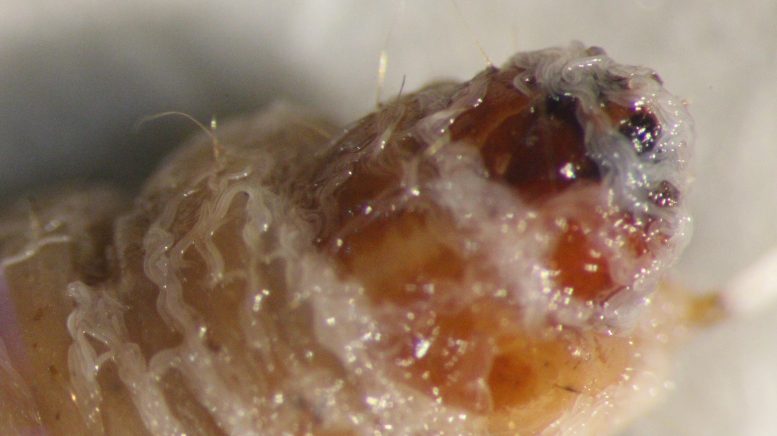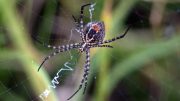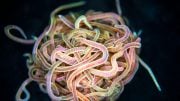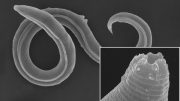
Researchers at UC Riverside have discovered Steinernema adamsi, a new nematode species that kills insects, offering a promising biological control option for crop pests in challenging climates. This discovery adds a valuable tool to sustainable agriculture and pest management, with potential applications in understanding ecological and evolutionary dynamics. Steinernema adamsi being released from the body of a deceased host. Credit: Adler Dillman / UCR
A new species of nematode has the potential to safeguard crops without the need for pesticides.
Scientists at UC Riverside have identified a new species of tiny worms capable of infecting and eliminating insects. Known as nematodes, these worms offer a potential solution for managing crop pests in warm and humid regions where other beneficial nematodes struggle to survive.
This new species is a member of a family of nematodes called Steinernema that have long been used in agriculture to control insect parasites without pesticides. Steinernema are not harmful to humans or other mammals and were first discovered in the 1920s.
Contributions to Agricultural Pest Control
“We spray trillions of them on crops every year, and they’re easy to buy,” said UCR nematology professor Adler Dillman, whose lab made the discovery. “Though there are more than 100 species of Steinernema, we’re always on the lookout for new ones because each has unique features. Some might be better in certain climates or with certain insects.”
Hoping to gain a deeper understanding of a different Steinernema species, Dillman’s laboratory requested samples from colleagues in Thailand. “We did DNA analysis on the samples and realized they weren’t the ones we had requested. Genetically, they didn’t look like anything else that has ever been described,” Dillman said.
Dillman and his colleagues have now described the new species in the Journal of Parasitology. They are nearly invisible to the naked eye, about half the width of a human hair and just under 1 millimeter long. “Several thousand in a flask looks like dusty water,” Dillman said.
They’ve named the new species Steinernema adamsi after the American biologist Byron Adams, Biology Department chair at Brigham Young University.
New nematode species Steinernema adamsi close up under a microscope. Credit: Adler Dillman / UCR
“Adams has helped refine our understanding of nematode species and their important role in ecology and recycling nutrients in the soil,” Dillman said. “He was also my undergraduate advisor and the person who introduced me to nematodes. This seemed a fitting tribute to him.”
Adams, who is currently doing research on nematodes in Antarctica, said he is honored to have such a “cool” species bear his name in the scientific literature.
Unique Features and Future Research
“The biology of this animal is absolutely fascinating,” Adams said. “Aside from its obvious applications for alleviating human suffering caused by pest insects, it also has much to teach us about the ecological and evolutionary processes involved in the complex negotiations that take place between parasites, pathogens, their hosts, and their environmental microbiomes.”
Learning about these worms’ life cycles as an undergraduate is what hooked Dillman on studying them. As juveniles, nematodes live in the soil with sealed mouths, in a state of arrested development. In that stage, they wander the soil looking for insects to infect. Once they find a victim, they enter the mouth or anus and defecate highly pathogenic bacteria.
“A parasite that poops out pathogenic stuff to help kill its host, that’s unusual right out of the gate,” Dillman said. “It’s like something out of a James Cameron movie.”
Within 48 hours of infection, the insect dies. “It essentially liquefies the insect, then you’re left with a bag that used to be its body. You might have 10 or 15 nematodes in a host, and 10 days later you have 80,000 new individuals in the soil looking for new insects to infect,” Dillman said.
The researchers are certain that S. adamsi kills insects. They confirmed this by putting some of them in containers with wax moths. “It killed the moths in two days with a very low dose of the worms,” Dillman said.
Going forward, the researchers hope to discover the nematode’s unique properties. “We don’t know yet if it can resist heat, UV light, or dryness. And we don’t yet know the breadth of insects it is capable of infecting.
However, S. adamsi are members of a genus that can infect hundreds of types of insects. Therefore, the researchers are confident it will be beneficial on some level whether it turns out to be a specialist or a generalist parasite of multiple types of insects.
“This is exciting because the discovery adds another insect killer that could teach us new and interesting biology,” Dillman said. “Also they’re from a warm, humid climate that could make them a good parasite of insects in environments where currently, commercially available orchard nematodes have been unable to flourish.”
Reference: “Steinernema adamsi n. sp. (Rhabditida: Steinernematidae), a new entomopathogenic nematode from Thailand” by Anil Baniya, Chanakan Subkrasae, Jiranun Ardpairin, Kyle Anesko, Apichat Vitta and Adler R. Dillman, 9 February 2024, Journal of Parasitology.
DOI: 10.1645/23-60









Be the first to comment on "“Fascinating” New Animal Discovery Could Protect Crops Without Pesticides"